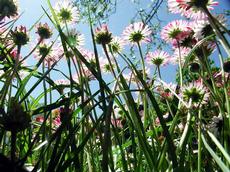Plant diversity determines biodiversity
A decline in plant species diversity works in a cascading effect to reduce the abundance and the diversity of all members of the food chain. This has emerged from a study undertaken as part of one of the world's largest biodiversity experiments, in which researchers from Zurich are taking part.

In the natural world, life is cruel. Eat and be eaten is the maxim; each life feeds off another. Plants are eaten by herbivores, which in turn fall prey to carnivores or omnivores, which then devour one another or succumb to parasite infestation. Finally, the carcasses are disposed of by scavengers. A whole network of reciprocal interrelationships extends across a number of what are known as trophic levels.
To be found at the very lowest trophic level are the so-called primary producers – the plants, which, contrary to previous assumptions, have a considerable impact on species diversity as a whole. This has been shown by a study recently published in “Nature”, which summarises the results of a long-term experiment.
Grassroots movement
Until now, science has assumed that the predatory organisms at the top of the food pyramid control biodiversity from the top down. In their study, however, the researchers have concluded that plants have a much greater influence on the diversity of species than previously thought. If the number of plant species within an ecosystem declines, then the diversity of all other organisms also dwindles – and this effect is felt both above and below ground. In the first instance, the diversity of the herbivores is affected. After this, the diversity of omnivores and carnivores also declines.
The bottom-up effect is felt most strongly above ground. The response of soil organisms, in contrast, is consistently weaker. The researchers were also able to show that a high level of species diversity stems the invasion of weeds, pathogen infestation and hyperparasitism, i.e. parasites on parasites. In species-rich plant populations, these had fewer chances of finding a host or of becoming established. All niches were already occupied when they arrived. Individual plants, however, are much less readily attacked by pests when there is a higher level of diversity as opposed to a monoculture. Species already present, meanwhile, responded positively to a local increase in plant diversity.
In addition to the biodiversity of the other organisms, the diversity of the plant species present thus also controls their population density and their relationships with other levels of the food chain. These effects take place directly and not as a function of the biomass of the plants, which is also diversity-related. Even if the plant biomass were to be increased by means of manuring, the diversity of consumers and predators would not simply increase. This occurs only with a high level of plant diversity.
The food chain examined as a whole
The evidence for this bottom-up approach has been produced as part of the “Jena Experiment”, a research project being conducted by an international research group on a former piece of open land near the city of Jena. The experiment is Europe's largest biodiversity experiment. The study is analysing the effect of variations in plant diversity on all other levels of the food chain. This enables entire food webs, and not just isolated components, to be examined.
Nina Buchmann, Professor of Grassland Sciences at ETH Zurich, is one of the scientists taking part in the study. She has been involved from the very beginning and together with Bernhard Schmid (University of Zurich) and Markus Fischer (University of Bern) investigated the botanical component of the research. She and her group have analysed the biomass, i.e. the plant output, and the emissions of greenhouse gases from the soil, and characterised the ecophysiology of the vegetation cover.
For the study, which began in 2002, the researchers created more than 80 experimental plots sown with meadow plant seed mixtures on a former piece of open land near Jena. These experimental plots are up to 400 square metres in size.
Plant diversity is effective against biological pests
Nina Buchmann sees the relevance of the study in particular in relation to land use. Land use often massively alters the natural vegetation and the species diversity of an ecosystem. As a result, intensively exploited meadows and pastures, for instance, are mostly very species-poor. “With our data, we're able to show that for most organism groups and their reciprocal effects, the consequences of the loss of plant diversity are often negative”, says Buchmann. The feedback effects are said to be far-reaching on all trophic levels.
However, the ETH professor also points out that it was only as a result of many years of research in a major co-operative project that these findings could be achieved. “Environmental research requires a long-term commitment”, she emphasises, and hopes that the funds for this experiment will also be committed for the long term. The „Jena Experiment”, for which funding has been provided for a further three years, should be continued so that environmental processes that change only slowly can also be investigated. “What goes on under the ground often only becomes visible a decade later”, says Buchmann.
The researchers hope that this study will open the way for further investigations in the area of biodiversity – for instance, in order to monitor whether and to what extent the proven cascading diversity effect also applies to other systems, for instance in forests or underwater.
References:
Scherber Ch et al.: Bottom-up effects
of plant diversity on multitrophic interactions in a biodiversity experiment,
Nature, Vol. 467, No. 7319 (2010), doi: 10.1038/nature09492







READER COMMENTS